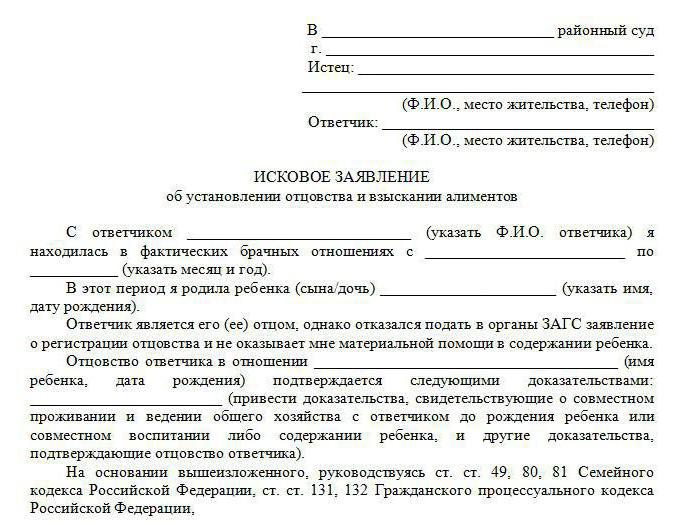The term for consideration of the statement of claim in court is the period of time that is given to the court to conduct the proceedings and make a decision on the claim. What does it mean for the court and the participants in the trial? And what is a lawsuit?
Legislative regulation
The time period for consideration of a statement of claim in court is governed primarily by the rules of the procedural code, in the case of civil cases, by the Civil Procedure Code.
Art. 154 Code of Civil Procedure is the main, it contains a general rule on the timing of consideration. District courts have 2 months, world courts - a month to decide on the claim.

Legislation may establish other terms. There is a procedure for suspending the flow of time on the case.
The time period for consideration of a statement of claim in court may be established indirectly by the chairman of the court upon a complaint of a party. Unjustified delay in resolving a dispute gives the right to demand compensation to the plaintiff. We will have to prove that the reason for the delay is the actions of the judge.
Drawing up a claim
A lawsuit is a statement by a person about a violation of his rights and the measures that he asks to take in order to protect or restore his rights.
The application is compiled in accordance with the procedural codes (Code of Civil Procedure, CAS, agribusiness). When choosing samples of statements of claim in court, one must take into account what kind of legal proceedings are in question.

The court either receives the appropriate number of copies to be sent to other participants, or evidence that a copy of the claim with the attached materials has already been sent to them.
Samples are offered either in the form of forms, or compiled in such a way that it only remains to insert the names of the plaintiff and defendant. The application is typed on a computer and sent in paper or electronic form to the court.
Procedure for filing and accepting a claim
The stages of production are described in sufficient detail in the procedural legislation.
Art. 133 Code of Civil Procedure of the Russian Federation gives the court 5 days to resolve the issue of accepting the claim for production. What does it look like?
The submitted documents are directly submitted to the clerk of the court in person, through a representative or by mail. Not so long ago, it became possible to file a lawsuit in electronic form. An indispensable condition is the certification with a digital signature.

In life, the material is not transmitted immediately, but after a day or longer. It all depends on the quality of the organization of the court and its workload.
Next, the assistant or judge examines the received material for compliance with the law.
The procedure for consideration by the court of a statement of claim provides for the adoption of a decision in the form of a determination based on the results.
An electronic system speeds up the filing and review process. Parties have access to all case materials from the moment they are entered into the system. The pursuit of video conferencing will further simplify and speed up production.
How are production dates calculated?
The term is measured in days, months, and years. Holidays or weekends with which the deadlines expire, means their automatic extension to the next working day.

The time of the proceedings, regardless of whether a civil, administrative or arbitration case is being considered, includes the time to accept the application, hold a preliminary meeting, as well as meetings when the dispute is considered on the merits. This also includes the time spent by the court in the deliberation room until its announcement.
What decisions does the court make?
The judge has several options:
- open production;
- refuse to open a case;
- return the claim to the plaintiff;
- leave the claim motionless and then return it to the applicant.
The judge informs the plaintiff first of all about the results of the consideration of the claim. Other participants in the process receive a message with copies of the case if the judge decided to open the case.

A note is made in the electronic database on the transfer of materials to the office, which is required to send them to the post office. Often confusion arises, and inexperienced plaintiffs wait months for reports of the fate of their lawsuit. If there is no news for a month or two, you should call the court or visit him in person.
Refusal to open production
A court refusal to consider a statement of claim is accepted if one or more of the grounds exist. The difference with the denial of the claim is that the judge does not need to consider the claim on the merits.
What are the reasons for this?
- The application should be considered in another area of production, for example, administrative.
- The application was sent by an unauthorized person.
- Previously, a dispute between the same persons, on the same grounds, has already been examined by a state court.
- Previously, a dispute was considered between the same persons on the same grounds by the arbitral tribunal, unless it was refused to issue a writ of execution on it.
The difference between the refusal to return the claim is that after the application is no longer filed again. The only way out is to appeal the decision to refuse.
The cancellation of the refusal of the appeal obliges the trial court to begin consideration of the case. With the adoption of the determination begins the countdown of the review period.
Return of claim
Art. 135 Code of Civil Procedure lists the reasons giving the court a reason to return the statement to the plaintiff. And he has a choice - appeal the return or take into account what the court said and send a new lawsuit.

Unscrupulous judges use the legal institution as a means of pressure, and the only way out is an appeal, especially if the statute of limitations has been missed when a new lawsuit is filed.
The decision to return is also made within 5 days after the materials are received in court.
If the return was found to be unlawful on appeal, the time limit for the proceedings is counted from the moment the court of first instance takes the case to production.
Motionless
The judge, believing that the lawsuit has been filed and at the same time articles 131 and 132 of the Code of Civil Procedure have not been fully implemented, leaves him without movement. The plaintiff is given time to remove defects. In this case, there is no deadline for the court’s response to the statement of claim, but by analogy, the norm of 5 days applies. Plaintiffs receive approximately 2 weeks to rectify deficiencies from the day the judge ruled.
An application is sent to the court with reference to the court ruling and either the amended claim, or additional copies of documents that were not previously calculated, or the receipt of payment of the state duty are attached. In practice, there are many reasons why judges leave the lawsuit motionless. Moreover, the fact that one judge does not even consider it a disadvantage can be a serious obstacle for another minister of Themis.
Timely corrections oblige you to count the production time from the day that the lawsuit was filed with defects.
Production suspension
Art. 215 and 216 of the Civil Procedure Code list the circumstances in which the proceedings are suspended. For example, a person who is a party to the process dies, or you need to wait until another matter is decided, without the results of which no decision can be made on the current dispute. The most common suspension of production due to the appointment of expertise.

The suspension is not limited to specific dates, it all depends on the circumstances. For example, how soon the successor of the deceased will be discovered or how soon the expert will conduct an examination. Suspension means the automatic temporary cessation of the flow of time.
Deferred review
Art. 169 Code of Civil Procedure gives the court the right to adjourn the proceedings.Common reasons: one party’s failure to appear, demanding evidence, the need to bring additional persons to the proceedings.
When the proceedings are postponed, the terms continue their course, and the judge must schedule a new meeting within the allotted time.
Features of consideration in a magistrate court
Justices of the peace bear the burden of considering claims at a price of up to 50 thousand rubles, as well as of terminating a marriage if the spouses do not have children in common and use common property.
As a rule, disputes that reach magistrates are obvious, because of which a month-long deadline for consideration of a statement of claim in a magistrate’s court is set.
Rules on suspension and postponement of production continue to apply.
The terms of consideration of a statement of claim in a court of world justice are carried out only where the workload is minimal (urban settlements, sparsely populated areas, etc.).
Simplified Production
In the cases provided, the decision is made without calling the parties. The judge, having received the documents and checking them, sends copies to the defendant and third parties. The parties are given two weeks to provide additional evidence and arguments, especially by the defendant.
In this case, formally, the trial lasts no more than 20 days, but taking into account the time spent on mail, a month or two.
Arbitration
The term for consideration of a claim in an arbitration court is somewhat longer - 3 months. Suspension and adjournment of proceedings - the basis for the suspension of the timing of the proceedings.
However, these are general rules; the code sets out a different time frame for a number of disputes. For example, no more than 2 months are allowed for simplified production.
Administrative proceedings
CAS RF gives the courts 2 months to resolve the dispute. The RF Armed Forces has 3 months. The time limits for consideration by the court of an administrative statement of claim are taken from the Civil Procedure Code.
Case review
The legislation provides for instances reviewing court decisions on complaints from the parties. Higher authorities are also limited in time.
A 2-month period is given for review (sometimes 3 months are given) from the moment the case is transferred to a court of appropriate jurisdiction.
Most often, the appeals instance completely reviews cases, the appeal and supervision have the right to cancel the decision and send the case to the appeal or the first instance without taking a final decision on the suit.
The case is reviewed on the merits or not, the time limit for consideration does not change.
Extension of proceedings
The complexity of the case or other circumstances give the court the right to extend the proceedings by an average of a month, depending on the norms of which code the dispute is resolved.
At the same time, the agribusiness prohibits the extension of time in simplified production.
The workload of the courts, the problems in the work of the post office make it extremely rare for judges to fit into the time allotted to them, and the right to extend the proceedings is of little practical importance.
Statute of limitations for going to court
The deadline for filing a lawsuit in court is determined either by material legislation (Civil Code, other laws), or procedural (Code of Civil Procedure, CAS, AIC). On average, in civil and arbitration cases, a 3-year period is set, the minimum - 10 days according to CAS for filing a complaint about the actions of a bailiff.
Applicants should take into account the statute of limitations, otherwise the judge will either not accept the claim for proceedings or refuse it after the second party has declared the deadline. Samples of statements of claim to the court may directly include a request for the restoration of the time limit for filing a claim with an explanation of the reasons for the omission.
The arbitration proceedings also oblige to observe the pre-trial reconciliation procedure within the statute of limitations, so that the court has the right to accept the claim. Having no information about the preliminary claim, the judge will return the statement.